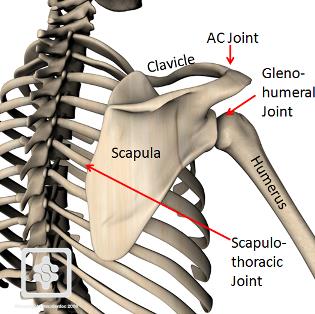http://drbenkim.com/exercises-shoulder-capsules-blades.htm
Posted by Dr. Ben Kim
 Another way to keep your shoulder capsules healthy is to ensure fluid movement of your shoulder blades against your ribcage. Your shoulder blades (scapulae) lie against the back of your ribcage, creating a "pseudo joint," sometimes called the scapulothoracic joint. For every two degrees of elevation that your shoulders (glenohumeral joints) experience, in order for all surrounding tissues to avoid unnecessary stress like impingement, your scapulothoracic joints need to rotate about one degree.
Another way to keep your shoulder capsules healthy is to ensure fluid movement of your shoulder blades against your ribcage. Your shoulder blades (scapulae) lie against the back of your ribcage, creating a "pseudo joint," sometimes called the scapulothoracic joint. For every two degrees of elevation that your shoulders (glenohumeral joints) experience, in order for all surrounding tissues to avoid unnecessary stress like impingement, your scapulothoracic joints need to rotate about one degree.
Posted by Dr. Ben Kim
Below the layers of skin, fascia, and muscle that surround your shoulders are a series of ligaments that meld together to form a capsule, one per shoulder; it's job is to prevent your shoulder from dislocating, while still providing enough give to allow a wide range of motion.
Over time, overt or repeat micro injuries to your shoulder capsules can lead to diminished range of motion, inflammation, and pain.
A highly effective way to keep your shoulder capsules healthy is to do forward and backward shoulder circles.
Begin standing with your feet about shoulder width apart, and raise your arms to your sides until they are about parallel with the floor.
Point your thumbs forward, then slowly turn your arms in small circles going forward. Do five to ten of these circles, then turn your thumbs to point behind you, and do another five to ten shoulder circles going backward.
Here's a short video clip that shows how this is done:
If you can't do shoulder circles while keeping your arms parallel with the floor, feel free to try them with your arms at a lower angle, one that doesn't create any discomfort. This exercise shouldn't cause pain, so be sure to find an angle that feels manageable.
As you get used to doing shoulder circles, feel free to increase repetitions and even do a few sets each way. Putting your shoulders through these circles for a minute or two daily can go a long way towards keeping your shoulder capsules well perfused with blood.
 Another way to keep your shoulder capsules healthy is to ensure fluid movement of your shoulder blades against your ribcage. Your shoulder blades (scapulae) lie against the back of your ribcage, creating a "pseudo joint," sometimes called the scapulothoracic joint. For every two degrees of elevation that your shoulders (glenohumeral joints) experience, in order for all surrounding tissues to avoid unnecessary stress like impingement, your scapulothoracic joints need to rotate about one degree.
Another way to keep your shoulder capsules healthy is to ensure fluid movement of your shoulder blades against your ribcage. Your shoulder blades (scapulae) lie against the back of your ribcage, creating a "pseudo joint," sometimes called the scapulothoracic joint. For every two degrees of elevation that your shoulders (glenohumeral joints) experience, in order for all surrounding tissues to avoid unnecessary stress like impingement, your scapulothoracic joints need to rotate about one degree.
For many people who "turtle," or slouch forward with their shoulders and chest, scapulothoracic action is dysfunctional, which inevitably leads to a decrease in space in the front shoulder region (sub-acromial space), which sets the stage for chronic shoulder pain and stiffness.
The best way to maintain healthy movement between your shoulder blades and rib cage is to do an exercise that I learned long ago from physiotherapist, Pete Egoscue, one that I call the shoulder hinge exercise.
Begin standing against a wall with your feet about shoulder width apart.
Cup your ears with your hands or fingers, and begin with the backs of your elbows touching the wall.
Keep your back against the wall and your fingers on your ears, and slowly bring your elbows out in front of you until they meet.
If you can't bring your elbows to touch one another, just go as far as you can without causing discomfort, and be sure to keep your fingers cupping your ears and your back against the wall.
Now bring your elbows back against the wall, and repeat this "hinge" action several times.
Here's a brief video clip that illustrates this shoulder hinge exercise:
And there you have it - two simple exercises that are powerfully effective in preventing and even treating chronic shoulder problems like tendonitis, bursitis, and adhesive capsulitis (frozen shoulder).
Please consider sharing these exercises with family members and friends who are interested in self health care.





Комментариев нет:
Отправить комментарий